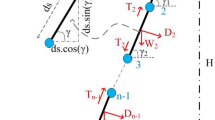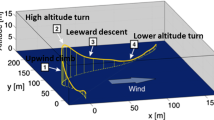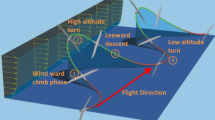Abstract
This work aims to contribute to the innovation in the urban air mobility and delivery sector and represents a starting point for air logistics and its future scenarios. The dissertation focuses on modeling, simulation, and control of a formation of multirotor aircraft for cooperative load transportation, with particular attention to the stabilization of payload swing motion. Starting from the mathematical model of two identical multirotors, formation-flight-keeping and collision-avoidance algorithms are implemented to ensure the safety of the vehicles within the formation and that of the payload. Then, a mathematical model for the suspended load is implemented, as well as an active controller for its stabilization. The focus of this section is thus represented by the analysis of payload oscillatory motion, whose kinetic energy decay is investigated. Several test cases are presented to establish the most effective and safe strategy in light of future aerospace applications.












Similar content being viewed by others
References
Valavanis, K.P.: Advances in unmanned aerial vehicles: state of the art and the road to autonomy. In: Micro-Processor-Based and Intelligent Systems Engineering Series, pp. 15–46. Springer-Verlag, Berlin (2007)
Avanzini, G., de Angelis, E.L., Giulietti, F.: Optimal performance and sizing of a battery-powered aircraft. Aerosp. Sci. Technol. 59, 132–144 (2016). https://doi.org/10.1016/j.ast.2016.10.015
Gatti, M., Giulietti, F., Turci, M.: Maximum endurance for battery-powered rotary-wing aircraft. Aerosp. Sci. Technol. 45, 174–179 (2015). https://doi.org/10.1016/j.ast.2015.05.009
de Angelis, E.L., Ferrarese, G., Giulietti, F., Modenini, D., Tortora, P.: Gaussian deterministic recursive estimator with online tuning capabilities. J. Guid. Control. Dyn. 38(9), 1827–1833 (2015). https://doi.org/10.2514/1.G001024
de Angelis, E.L., Ferrarese, G., Giulietti, F., Modenini, D., Tortora, P.: Terminal height estimation using a Fading Gaussian Deterministic filter. Aerosp. Sci. Technol. 55, 366–376 (2016). https://doi.org/10.1016/j.ast.2016.06.013
de Angelis, E.L., Giulietti, F., Pipeleers, G.: Two-time-scale control of a multirotor aircraft for suspended load transportation. Aerosp. Sci. Technol. 84, 193–203 (2019). https://doi.org/10.1016/j.ast.2018.10.012
de Angelis, E.L., Giulietti, F., Rossetti, G.: Multirotor aircraft formation flight control with collision avoidance capability. Aerosp. Sci. Technol. 77, 733–741 (2018). https://doi.org/10.1016/j.ast.2018.04.002
Balch, T., Arkin, R.C.: Behavior-based formation control for multirobot teams. IEEE Trans. Robot. Autom. 14(6), 926–939 (1998). https://doi.org/10.1109/70.736776
Noormohammadi Asl, A., Menhaj, M.B., Sajedin, A.: Control of leader-follower formation and path planning of mobile robots using Asexual Reproduction Optimization (ARO). Appl. Soft Comput. 14, 563–576 (2014). https://doi.org/10.1016/j.asoc.2013.07.030
Rahimi, R., Abdollahi, F., Naqshi, K.: Time-varying formation control of a collaborative heterogeneous multi agent system. Robot. Auton. Syst. 62(12), 1799–1805 (2014). https://doi.org/10.1016/j.robot.2014.07.005
Aghaeeyan, A., Abdollahi, F., Talebi, H.A.: UAV-UGVs cooperation: with a moving center based trajectory. Robot. Auton. Syst. 63, 1–9 (2015). https://doi.org/10.1016/j.robot.2014.10.005
Panagou, D., Kumar, V.: Cooperative visibility maintenance for leader-follower formations in obstacle environments. IEEE Trans. Rob. 30(4), 831–844 (2014). https://doi.org/10.1109/TRO.2014.2304774
Peng, Z., Wen, G., Rahmani, A., Yu, Y.: Leader-follower formation control of nonholonomic mobile robots based on a bioinspired neurodynamic based approach. Robot. Auton. Syst. 61(9), 988–996 (2013). https://doi.org/10.1016/j.robot.2013.05.004
Nonami, K., Kendoul, F., Suzuki, S., Wang, W., Nakazawa, D.: Autonomous flying robots: unmanned aerial vehicles and micro aerial vehicles, pp. 22–24. Springer, Tokyo (2010)
Barraquand, J., Langlois, B., Latombe, J.-C.: Numerical potential field techniques for robot path planning. IEEE Trans. Syst. Man Cybern. 22(2), 224–241 (1992). https://doi.org/10.1109/21.148426
Paul, T., Krogstad, T.R., Gravdahl, J.T.: UAV formation flight using 3D potential field. In: 2008 16th Mediterranean Conference on Control and Automation, pp. 1240–1245 (2008). https://doi.org/10.1109/MED.2008.4601984
Klausen, K., Fossen, T.I., Johansen, T.A.: Nonlinear control with swing damping of a multirotor UAV with suspended load. J. Intell. Robot. Syst. 88(2), 379–394 (2017). https://doi.org/10.1007/s10846-017-0509-6
Talbot, P.D.: A mathematical model of a single main rotor helicopter for piloted simulation, pp. 1–52. NASA Technical Memorandum 84281 (1982)
de Angelis, E.L.: Swing angle estimation for multicopter slung load applications. Aerosp. Sci. Technol. 89, 264–274 (2019). https://doi.org/10.1016/j.ast.2019.04.014
Department of defense: World geodetic system 1984 - Its definition and relationship with local geodetic systems, DMA Technical Report 8350.2, 1–170 (1991)
Deters, R.W., Krishnan, G.K.A., Selig, M.S.: Reynolds number effects on the performance of small-scale propellers. https://doi.org/10.2514/6.2014-2151
Leishman, G.J.: Principles of helicopter aerodynamics, 2nd edn, Chap. 2–5. Cambridge University Press, New York (2006)
Padfield, G.D.: Helicopter flight dynamics: the theory and application of flying qualities and simulation modeling, 2nd edn, Chap. 3. Blackwell Pub, Oxford (2007)
U.S. Government Printing Office: US standard atmosphere, pp. 1–24. NOAA-S/T 76-1562, Washington, DC (1976)
Author information
Authors and Affiliations
Corresponding author
Ethics declarations
Conflict of Interest
The corresponding author states that there is no conflict of interest.
Additional information
Publisher's Note
Springer Nature remains neutral with regard to jurisdictional claims in published maps and institutional affiliations.
Rights and permissions
Springer Nature or its licensor (e.g. a society or other partner) holds exclusive rights to this article under a publishing agreement with the author(s) or other rightsholder(s); author self-archiving of the accepted manuscript version of this article is solely governed by the terms of such publishing agreement and applicable law.
About this article
Cite this article
Costantini, E. Modeling, Simulation, and Control of a Formation of Multirotor Aircraft for Transportation of Suspended Loads. Aerotec. Missili Spaz. (2023). https://doi.org/10.1007/s42496-023-00192-3
Received:
Revised:
Accepted:
Published:
DOI: https://doi.org/10.1007/s42496-023-00192-3




